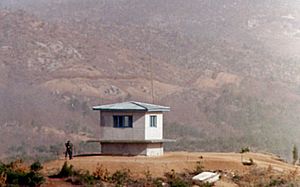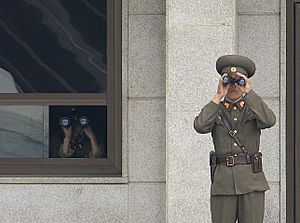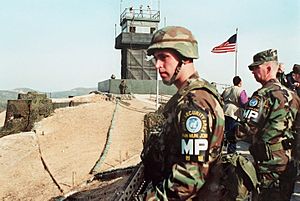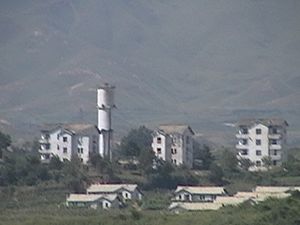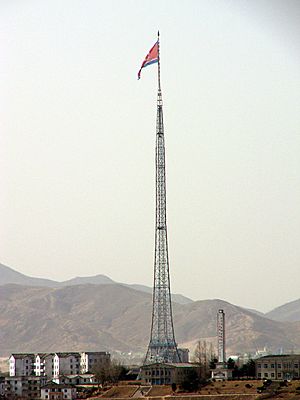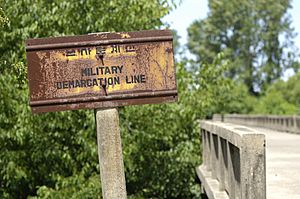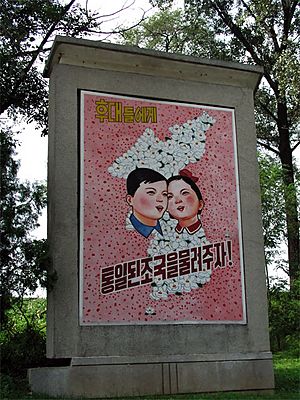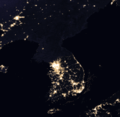Korean Demilitarized Zone facts for kids
Quick facts for kids Korean Demilitarized Zone |
|
|---|---|
| Korean Peninsula | |
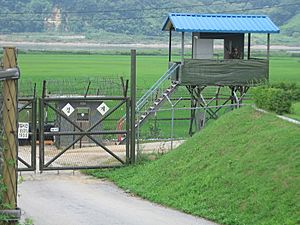
A South Korean checkpoint in the DMZ
|
|

The Korean DMZ is shown in red with the Military Demarcation Line (MDL) shown with the black line
|
|
| Type | DMZ |
| Site information | |
| Controlled by | |
| Open to the public |
Restricted - No Public Access |
| Condition | Fully manned and operational |
| Site history | |
| Built by | |
| In use | July 27, 1953 onwards |
| Events | Division of Korea |
The Korean Demilitarized Zone (DMZ) is a special strip of land that stretches across the Korean Peninsula. It acts like a buffer zone between North and South Korea. This zone cuts the Korean Peninsula almost in half, crossing the 38th parallel.
The DMZ is about 250 kilometres (160 miles) long and 4 km (2.5 mi) wide. It is known as the most heavily guarded border in the world. The border between the two Koreas in the Yellow Sea is called the Northern Limit Line. Both sides of this sea border are also very well-protected.
Contents
History of the DMZ
The 38th parallel north is a line that divides the Korean peninsula. After World War II, this line separated the areas controlled by the United States and the Soviet Union. In 1948, when North and South Korea were formed, this line became their international border. It was a very tense area during the Cold War.
On June 25, 1950, North Korea invaded South Korea, starting the Korean War. This conflict lasted three years and caused many lives to be lost. International troops helped push the front line back near the 38th parallel.
The war ended with a ceasefire on July 27, 1953. This agreement created the DMZ. Both sides agreed to move their troops back 2,000 m (2,200 yards) from the front line. This created the 4 km (2.5 mi) wide buffer zone. The Military Demarcation Line (MDL) runs right through the middle of the DMZ. It shows where the front line was when the agreement was signed.
The war ended in a stalemate, meaning neither side truly won or lost. Because of this, North and South Korea are still technically enemies. Many soldiers are stationed along both sides of the DMZ. Soldiers can patrol inside the DMZ, but they cannot cross the MDL. There have been outbreaks of violence along the DMZ since 1953.
Only two villages were allowed to remain inside the DMZ: Tae Sung Dong and Kijong-dong. People living in Tae Sung Dong are protected by the United Nations Command. They must live in the village for at least 240 nights a year to keep their residency. In 2008, 218 people lived there. These villagers are descendants of people who owned the land before the Korean War.
Joint Security Area: A Meeting Place
Inside the DMZ, near the west coast, is a place called Panmunjeom. This is where the Joint Security Area (JSA) is located. For a long time, it was the only direct connection between North and South Korea. In 2007, a train crossed the DMZ to the North on a new rail line.
There are several buildings in the JSA, some built right on the MDL. The JSA is where all talks between the two Koreas have happened since 1953. The MDL even runs through the conference rooms and down the middle of the tables where North Korean and United Nations Command officials meet.
In late 2009, South Korean forces and the United Nations Command started making their guard posts and buildings in the JSA bigger and more modern. North Korea had finished similar work on their side a year earlier.
Secret Tunnels Under the DMZ
South Korea has found tunnels that cross under the DMZ. Explosives were used to build these tunnels. The way the blasting marks are shaped shows that the tunnels were dug from north to south. This means North Korea built them.
So far, four tunnels have been found. The first was discovered on November 15, 1974. North Korea said the tunnels were for coal mining. However, no coal has been found in them. All the tunnels were dug through hard rock called granite. Some tunnel walls were painted black to look like coal.
It is believed these tunnels were built for a possible North Korean military invasion. Each tunnel is large enough for an entire infantry division to pass through in one hour. But they are too small for tanks or other vehicles. The tunnels go in a north-south direction and do not have side branches. The tunnels found later show more advanced building techniques. For example, the third tunnel sloped slightly upwards to prevent water from collecting. Today, visitors can take guided tours to see the second, third, and fourth tunnels.
Villages and Buildings in the DMZ
Both North and South Korea have "peace villages" that can be seen from the other side of the DMZ. In the South, Daeseong-dong is managed under the rules of the DMZ. Its villagers are considered citizens of South Korea.
In the North, Kijong-dong has brightly painted, multi-story buildings with electric lights. These features were very luxurious for rural Koreans in the 1950s. The town was built so that its bright blue roofs and white sides would be easy to see from the border. However, with strong telescopes, it's clear that the buildings are just concrete shells. They have no window glass or inside rooms. Lights are turned on and off at certain times, and empty sidewalks are swept to make it look like people live there.
Until 2004, huge loudspeakers on some buildings in North Korea constantly played DPRK propaganda towards the South. They also broadcast propaganda radio messages.
Inside the JSA, there are several U.N. buildings called Conference Row. These are used for direct talks between the two Koreas. In 1994, North Korea made its Panmungak building taller. In 1998, South Korea built a new Freedom House for its Red Cross staff. This building was also meant to host reunions for families separated by the Korean War.
In the 1980s, South Korea built a 98.4 m (323 ft) flagpole in Daeseong-dong. North Korea responded by building an even taller one, 160 m (525 ft) high, in Kijong-dong. This was the tallest flagpole in the world.
Transportation Across the DMZ
Panmunjeom is where the talks that ended the Korean War happened. It is the main place where people are active in the DMZ today. The village is on the main highway and near a railroad that connects the two Koreas.
The railway connecting Seoul and Pyongyang was once called the Gyeongui Line. Today, South Korea still uses this name, but North Korea calls it the P'yŏngbu Line. This railway is mainly used to carry materials to the industrial complexes in Kaesong. South Korean workers also use it to travel there.
When the railway reopened in the early 2000s, it seemed like relations between the two countries were getting better. However, in November 2008, North Korea closed the railway because of rising tensions. It reopened in September 2009.
The road at Panmunjeom, known as Highway One in the South, was originally the only way to cross between the two countries. Both North and South Korea's roads end in the Joint Security Area. They don't meet because a 20-centimetre (8-inch) concrete line divides the site. People who are allowed to cross this border must do so on foot.
In 2007, the first train crossed the DMZ on the new Donghae Bukbu (Tonghae Pukpu) Line on Korea's east coast. This new rail line was built next to a road that took South Koreans to Kŭmgangsan. This area is culturally important for all Koreans. More than a million visitors crossed the DMZ until the route closed in July 2008. Since then, the resort and the Donghae Bukbu Line have been closed by North Korea.
On November 22, 2018, North and South Korea finished building a three-kilometer road along the DMZ. This road crosses the Korean MDL land border. It was reconnected for the first time in 14 years. This was done to help remove landmines and dig up Korean War remains at Arrowhead Hill in the DMZ.
Propaganda Along the Border
From 1953 until 2004, both sides used loudspeakers to broadcast audio propaganda across the DMZ. In 2004, North and South Korea agreed to stop these broadcasts.
On August 4, 2015, two South Korean soldiers were hurt by landmines. South Korea said North Korea had placed these mines. After this, both North and South Korea started broadcasting propaganda again. After four days of talks, South Korea agreed to stop the broadcasts when North Korea expressed regret for the incident.
On January 8, 2016, South Korea restarted broadcasts after North Korea claimed to have successfully tested a hydrogen bomb. In April 2016, South Korea bought a new stereo system to counter North Korea's broadcasts.
Both Koreas have also used balloons to send propaganda leaflets since the Korean War. Recently, South Korean non-governmental groups have launched balloons towards the DMZ and beyond. Like the loudspeakers, balloon operations were stopped between 2004 and 2010 by agreement.
Many North Korean leaflets during the Cold War gave instructions and maps to help South Korean soldiers defect. One leaflet found showed a map of a South Korean soldier's route when he defected to North Korea. North Koreans also used rockets to send leaflets to the DMZ.
On April 23, 2018, both North and South Korea officially ended their border propaganda broadcasts for good. On May 1, 2018, the loudspeakers were taken down. Both sides also promised to stop the balloon campaigns. A no-fly zone was set up on November 1, 2018. It bans all aircraft, including hot-air balloons, from flying within 25 kilometres (16 mi) of the Korean border's Military Demarcation Line (MDL).
Military Border Crossings
On December 12, 2018, soldiers from both Koreas crossed the DMZ's MDL into the other country. This was the first time in history they did this to check if guard posts had been removed.
On June 30, 2019, U.S. President Donald Trump became the first sitting U.S. president to enter North Korea. He did so at the DMZ line. After crossing into North Korea, Trump and Kim Jong-un met and shook hands. Kim said, "It's good to see you again," and "I never expected to meet you at this place." He also noted, "you are the first U.S. president to cross the border." Both men briefly crossed the border line before going back into South Korea.
On the South Korean side of the DMZ, Kim, Moon Jae-in, and Trump had a short chat. Then they held an hour-long meeting at the DMZ's Inter-Korean House of Freedom.
Nature Reserve: A Hidden Wildlife Haven
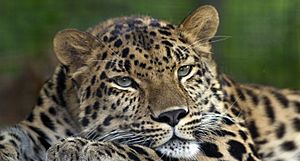
For the past 50 years, the Korean DMZ has been a dangerous place for humans. This has made it impossible for people to live there permanently. Only around the village of Panmunjeom and the Dong Bukbu Line on Korea's east coast have people been present regularly.
This natural isolation along the 155 miles (249 km) length of the DMZ has created a special "involuntary park." It is now known as one of the best-preserved areas of temperate habitat in the world. Many endangered animal and plant species now live among the fences, landmines, and listening posts.
These species include the very rare Red-crowned crane and the White-naped crane. It might also be home to the extremely rare Korean Tiger, Amur leopard, and Asiatic black bear. Ecologists have found about 2,900 plant species, 70 types of mammals, and 320 kinds of birds in this narrow buffer zone. More studies are being done in the area.
The DMZ has a wide variety of biodiversity because of its different landscapes. It includes mountains, prairies, swamps, lakes, and tidal marshes. Environmentalists hope that when North and South Korea reunite, the former DMZ will be kept as a wildlife refuge.
Images for kids
-
The Korean Demilitarized Zone is visible at night from space. There is a clear lack of lighting in the northern half of the Korean Peninsula.
-
The Korean wall, or anti-tank barrier, in the demilitarized zone seen through binoculars from the North Korean side.
-
DMZ, North Korea. Electric fences are used to separate North Korea from South Korea. Behind the fence, there is a strip with hidden land mines.
See also
 In Spanish: Zona desmilitarizada de Corea para niños
In Spanish: Zona desmilitarizada de Corea para niños


